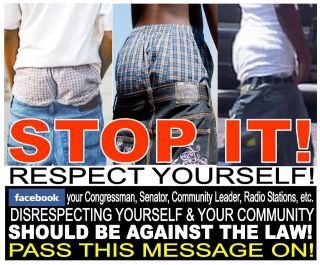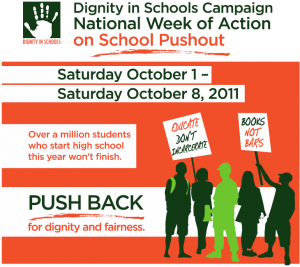Here is an article from Prison Culture blog which touches on a "popular" example of what is going on.
SAGGING PANTS, HYPERCRIMINALIZATION AND SCHOOL PUSHOUT
I came across this “ad” on a friend’s Facebook wall today.
Some people’s first reaction to this “ad” might be to chuckle at its utter ridiculousness. Surely the purveyors of this ad are not advocating that young people who wear sagging pants go to jail for this?!!!?? Unfortunately though, the reality is that some legislators are in fact advocating fines and community service for young people who don’t “pull up their pants.” Here’s an example from New Orleans:
Here’s an ad from a state senator in New York that attempts to couch the “war on sagging” within a historical context of racism.
The key sentence in the video for me is: “If we raise our pants, we raise our image.” The concept of being a “credit to one’s race” is deeply embedded in African American history. The state senator seems to be embracing the legacy of Booker T. Washington through his video. The sad thing is that for many African American youth pulling up their pants will NOT shift the deeply embedded image that the culture has of them as being “criminal” or “disposable.” It’s not about the clothes. Instead it is about what Amos Wilson has written:
“In the eyes of White America an exaggeratedly large segment of Black America is criminally suspect. This is especially true relative to the Black male. In the fevered mind of White America, he is cosmically guilty. His guilt is existential. For him to be alive is to suspected, to be stereotypically accused, convicted and condemned for criminal conspiracy and intent. On the streets, in the subways, elevators, in the “wrong” neighborhood (p.37).”
In the past, I have written about attempts to criminalize youth of color by outlawingsagging pants and have connected this to the way that prison clothing is used as a marker of criminality.
A few weeks ago I wrote briefly about Victor Rios’ new book “Punished: Policing the Lives of Black and Latino Boys.” In the book, Rios coins the term “youth control complex” which is defined as “a system in which schools, police, probation officers, families, community centers, the media, businesses, and other institutions systemically treat young people’s everyday behaviors as criminal activity.” The “war on sagging pants” is a perfect illustration of this “youth control complex” in action.
Rios writes about the impact of the “youth control complex” on the lives of young people of color:
Young people, who become pinballs within this youth control complex, experience what I refer to as hypercriminalization, the process by which an individual’s everyday behaviors and styles become ubiquitously treated as deviant, risky, threatening or criminal, across social contexts.This hypercriminalization, in turn, has a profound impact on young people’s perceptions, worldviews, and life outcomes. The youth control complex creates an overarching system of regulating the lives of marginalized young people, what I refer to as punitive social control.Hypercriminalization involves constant punishment. Punishment, in this study, is understood as the process by which individuals come to feel stigmatized, outcast, shamed, defeated, or hopeless as a result of negative interactions and sanctions imposed by individuals who represent institutions of social control.
These days, ground zero of the “youth control complex” can be found in our nation’s schools. Dr. Aaron Kupchik who studies school discipline issues has found that schools with large minority populations are more likely to have metal detectors. None of you will be surprised by this finding. However I want to make the point that the crackdown on sagging pants is integrally related to the types of zero tolerance policies enacted in most urban schools. In fact, some schools have begun to punish students who wear sagging pants on school property. It comes full circle.
Kupchick and his colleague Goeff Ward are particularly concerned about the use of metal detectors in schools.
Unlike the other four measures, Kupchik identifies metal detectors as invasive (“kids are patted down like they’re going through airport security”) and disruptive to learning environments.Further, he adds, metal detectors are more heavily aligned with the criminal justice system, and unlike locked gates, which restrict outside elements from coming into the schools, detectors presume students guilty of bringing items inside.
Scholars, educators, and young people from across the country are sounding the alarm about the intersection between schooling and youth hypercriminalization. From October 1 to 8, the Dignity in Schools Campaign (DSC), a coalition of educators and organizers, is spearheading theNational Week of Action on School Pushout. The Dignity in Schools Campaign’s National Week of Action brings together organizations and individuals from 13 states to call for an end to zero tolerance policies, for the implementation of positive approaches to discipline, like restorative justice practices and positive behavior supports instead of relying solely on suspensions and expulsions, and for the passage of federal legislation that promotes positive school climates.
I suggest that everyone read the Week of Action Platform (PDF) to learn about what’s at stake in the education of young people across the U.S. You can also find fact sheets about how these issues on playing out in your state on their website. Below is an example of one of their fact sheets:
.jpg/300px-Black_bike_week_Myrtle_Beach_SC_(4).jpg)



No comments:
Post a Comment